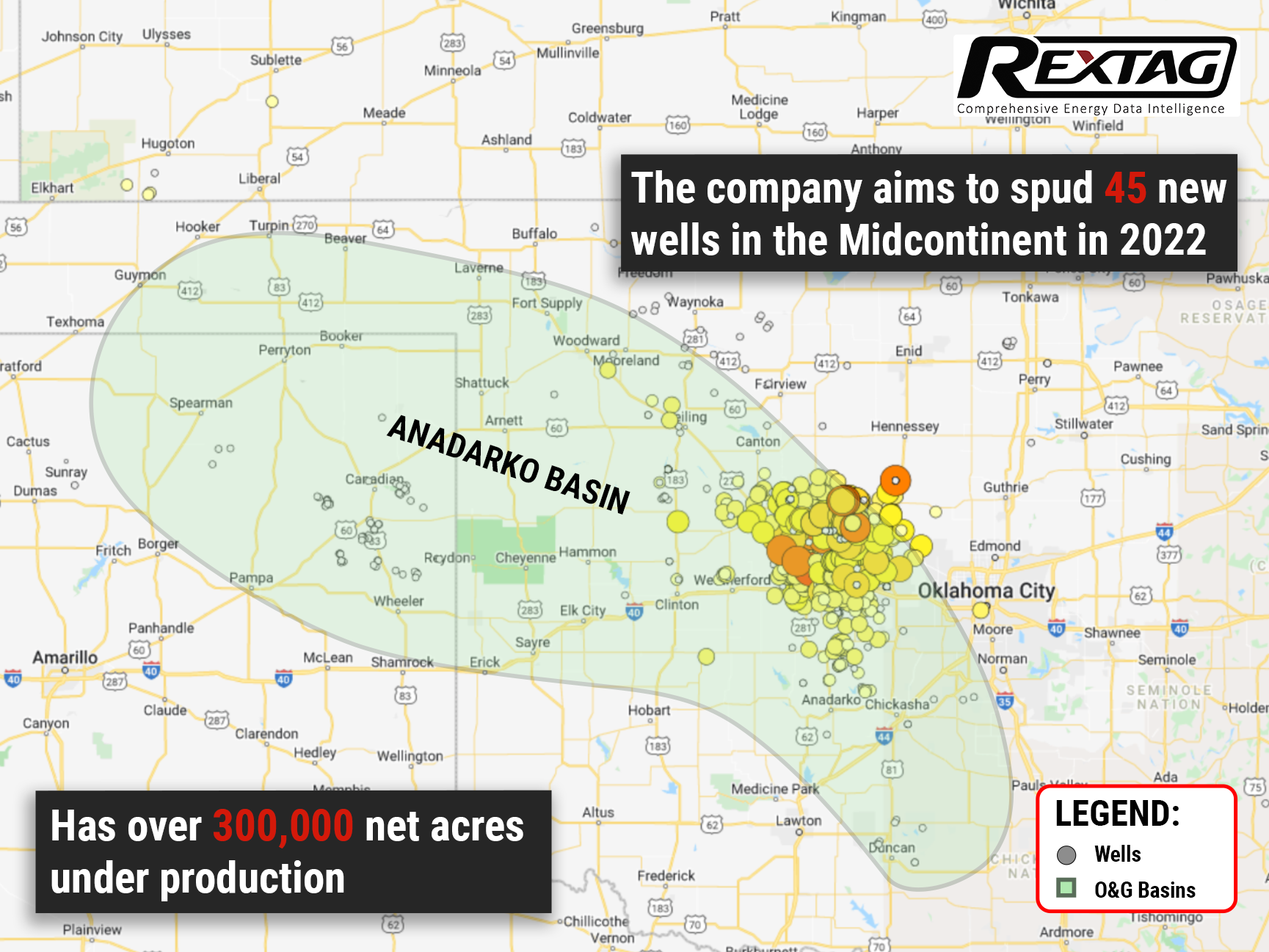Comprehensive Energy Data Intelligence
Information About Energy Companies, Their Assets, Market Deals, Industry Documents and More...
All In: Devon Energy is Banking on a Rebound for Anadarko
03/08/2022
Devon Energy Corp. intends to take advantage of its position in the Anadarko Basin to drive its cash return model. The company also intends to position itself as the leader for ESG within the industry.
The reason behind this move is simple: top management at Devon believes that the Anadarko Basin is a hidden treasure.
The number of rigs has increased by 180%, and production per rig is up. Technological advancements, longer laterals, and optimized completions are driving this trend. As the company has been in Anadarko all along, Devon will continue planning for the 300,000 net acres that they currently have within this basin, while others only becoming familiar with it at the moment.
Devon is implementing its cash return model when it comes to developing Anadarko Basin, which includes five key components — moderate growth, reduced investment rates, low leverage, fixed-plus-variable dividends, and ESG excellence, which generated $550 million in free cash flow by itself in 2021 alone.
Consequently, the Oklahoma City-based independent E&P company plans to drill 45 new wells in the Midcontinent by 2022, as well as to produce 600,000 boe/d across five operating basins, including the Eagle Ford Shale, Permian, Powder River, and Williston basins.
According to Aaron Ketter, a vice president at Devon Energy, Devon's approach to technology development is long-term. It is based on a consistent allocation of capital. These policies have been in place for decades. Data access, standardization, and trust form the foundations of this system. In line with this, technology teams and field teams, as well as vendor teams, are continually seeking net-zero improvement. Right now, that means using three different sensors to monitor emissions continuously — fixed cameras, a long-range laser network, and aerial laser surveys — to catch any harmful carbon or methane emissions.
Technology advances are bringing about a step change in the transition to observed emissions reporting. Devon will also work with agencies and NGOs in this regard, to conduct research and provide external reports. A preventative phase, methane fees, and carbon tax ensure the company does not become compliant, that any leaks are discovered as soon as possible, that they are fixed quickly, and that compliance is avoided.
However, it remains to be seen whether or not this strategy will produce the necessary results. We should note, however, that Devon Energy, Corp. (DVN) shares have surged 30.7% just this year alone amid recent macro uncertainties and rising energy prices. On both the topline and bottomline, Devon's recent fourth-quarter results were better than Street estimates.
Revenue increased by 233.8% to $4.27 billion, exceeding estimates by $1.04 billion. Earnings per share of $1.39 exceeded consensus by $0.15. Production growth in the Delaware basin and an increase in margins drove this performance. As of the end of the quarter, the company's total production averaged 611 thousand oil-equivalent barrels (Boe) per day.
It appears that they are doing something right, at least for the moment.
If you are looking for more information about energy companies, their assets, and energy deals, please, contact our sales office mapping@hartenergy.com, Tel. 619-349-4970 or SCHEDULE A DEMO to learn how Rextag can help you leverage energy data for your business.
Decline in US Oil and Gas Rigs Signals Continued Supply and Price Stability
![$data['article']['post_image_alt']](https://images2.rextag.com/public/blog/306_Blog_Decline in US Oil and Gas Rigs Signals Continued Supply and Price Stability (2).jpg)
The U.S. oil and natural gas rig count experienced a slight decline, falling by four to a total of 633 rigs for the week ending August 21. Despite this modest drop, industry analysts have noted a surprising resilience in both oil supply and natural gas prices as the year progresses, suggesting that the market may be more robust than previously anticipated.
Who's Next after Diamondback? Potential Takeover Targets in the Permian Basin
![$data['article']['post_image_alt']](https://images2.rextag.com/public/blog/239_Blog_Who's Next after Diamondback_ Potential Takeover Targets in the Permian Basin.png)
The $26 billion purchase of Endeavor Energy Resources by Diamondback Energy, with its stock up 2.6%, is the newest big deal combining oil and gas production in the Permian Basin under a few big companies
![$data['article']['post_image_alt']](https://images2.rextag.com/public/blog/328_Blog_Why Are Oil Giants Backing Away from Green Energy Exxon Mobil, BP, Shell and more .jpg)
As world leaders gather at the COP29 climate summit, a surprising trend is emerging: some of the biggest oil companies are scaling back their renewable energy efforts. Why? The answer is simple—profits. Fossil fuels deliver higher returns than renewables, reshaping priorities across the energy industry.
![$data['article']['post_image_alt']](https://images2.rextag.com/public/blog/327_Blog_Oil Market Outlook A Year of Growth but Slower Than Before.jpg)
The global oil market is full of potential but also fraught with challenges. Demand and production are climbing to impressive levels, yet prices remain surprisingly low. What’s driving these mixed signals, and what role does the U.S. play?
![$data['article']['post_image_alt']](https://images2.rextag.com/public/blog/326_Blog_USA Estimated Annual Rail CO2 Emissions 2035.jpg)
Shell overturned a landmark court order demanding it cut emissions by nearly half. Is this a victory for Big Oil or just a delay in the climate accountability movement?